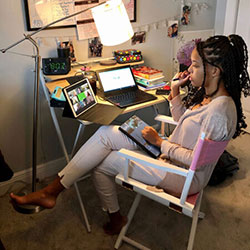With the COVID-19 pandemic, it is as if the world stops and everyone was forced to embrace the new normal. This does not limit to people who are working but also children who used to go to a school to study. However, an alternative for students to keep up is distance learning. But how healthy screen time can be a challenge for distance learning?
For many students today, distance learning has become the new normal. Classes happen on virtual meeting platforms, such as Zoom of Google Classroom. Kids are also stuck at a home during their free time. Some of the easy ways to pass time that offer are social media such as YouTube, Tiktok, and other online games.
How to Control a Healthy Screen Time for Distance Learning?
 A recent study shows that there are many young people getting plenty of screen time these days. Last April 2020, there are almost 1,500 parents in Canada reported their kids’ physical activity, screen time, and sleep habits since the pandemic hit.
A recent study shows that there are many young people getting plenty of screen time these days. Last April 2020, there are almost 1,500 parents in Canada reported their kids’ physical activity, screen time, and sleep habits since the pandemic hit.
To be able to control healthy screen time, The Canadian 24-Hour Movement Guidelines for Children and Youth submitted a recommendation. The movement recommends a two-hour screen time for children per day. This does not count school work toward this total, plus an additional 60 minutes of exercise for kids and teens ages 5 to 17.
Sleep recommendations vary based on age. A study looking at the results of this survey found that only around 2.5 percent of kids met all three guidelines. Nearly nine in every 10 exceeds the recommended two-hour daily limit on non-school screen time.
All Screen Time is Not Equal
In one 2019 study, Sanders looked at how kids spent their screen time. His group then investigated whether the type of screen time made a difference in mental or physical health or in school achievements. The researchers sorted screen time into five types: passive, interactive, social, educational, or something else.
Educational screen time was linked to doing better in school and had no bad health effects. More passive screen time was linked to worse outcomes in health and school achievement, the researchers found, compared with the other categories. But the impact was “quite small.” Problems showed up mainly in kids spending more than eight hours a day on screens.
Embracing the New Normal
Studies show that with the pandemic, everything seems to be done online. Not just the children are to adjust to distance learning. A lot of adults also do adjust to their work set-up. Most people are now working from home.
Also, other industries such as gambling also are leaning towards having their services online. In fact, according to sources of sports betting Korea, with the sports events are resuming, so does the bettors. However, with the threat of the virus, there is a significant number of bettors are using online sportsbooks to be able to place their bets.



